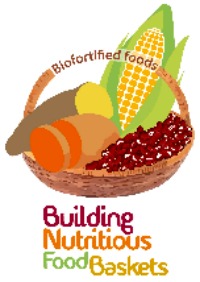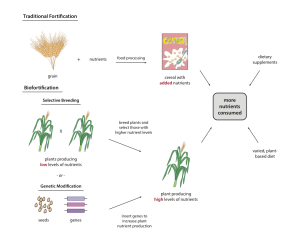
Introduction
- The term bio-fortification came from Greek word “bios” means “life” and Latin word “fortificare” means “make strong”
- Bio-fortification is the process of fortifying/increasing the nutritional quality of the foods through addition of micro nutrients via agronomic practices, modern biotechnological practices or conventional plant breeding
- It is a feasible and cost-effective method of providing micronutrient rich diet to the families which cannot afford/has no access to balanced diet
- Bio-fortification is similar with fortification in function as both of them increase the nutritional quality of the food. The major difference between them is that bio-fortification focuses on improving the nutritional content of the food during plant growth while fortification is done manually during processing of the crops.
- In case of bio-fortification, instead of adding micronutrients in the harvested food (done in normal fortification), the plants/crops are themselves altered so that they can produce nutrients on their own
- It is a useful method of fortification in contexts where conventional fortification and food supplementation activities cannot be performed effectively

- Some examples of bio-fortification include iron bio-fortification of rice, zinc bio-fortification of wheat, amino acid and protein bio-fortification etc.
- Bio-fortification is also an effective method of reaching to a larger population of poor people who are scattered in different regions and parts of the world
- This method is also considered as a successful food based approach to fulfill the gap of hidden hunger (i.e. micro nutrient deficiency) among the people of lower socio-economic groups. Therefore, also considered as a strategy to combat micronutrient deficiency.
- Bio-fortification is a great example of agriculture, health and nutrition sectors working in a combined way to produce better outcomes
Advantages of bio-fortification
- Bio-fortified crops have higher chances to serve the poor people as bio-fortification is mainly done in staple crops (e.g. wheat, maize, sweet potato etc.) which is a major source of nutrient for the poorer households/families
- It is highly cost effective method as only one time initial investment is needed to develop the fortified seeds/crops which fortify themselves later on. Also, there is no recurrent costs except some costs in maintenance breeding
- It is sustainable method of fortification as fortification passes from on from one generation to next generation of crops without further investment and effort (on bio-fortification)
- Bio-fortified crops have higher yielding along with higher disease resistant and drought tolerance
- This method is far more cheaper compared to addition of nutrients in the processed foods
In order to make the bio-fortification method effective, successful and scalable in all settings, below mentioned issues must be addressed. They are:
- Plant breeders must be able to find a crop with high micro-nutrient content which can be bred into local varieties
- Bioavailability of the crop must be ensured
- Nutritional effectiveness of bio-fortified crops must be established
- Both farmers and food consumers must have full acceptance towards this new food based approach and make it a part of their regular diet
Challenges in bio-fortification:
- Initial cost of research may be higher for developing and under-developed countries
- Difficulty in maintaining regulatory compliance as extremely precautionary regulations must be followed
- Fewer profit margins in the production and distribution of crops make it less attractive for the private sectors. Thus, scarcity of government funds may worsen the scenario for the public

References
http://www.who.int/elena/titles/biofortification/en/
http://harvestplus.org/biofortification-nutrition-revolution-now
http://biofortconf.ifpri.info/2013/12/12/what-is-biofortification/
http://www.sciencedirect.com/science/article/pii/S2211912417300068
http://jn.nutrition.org/content/136/4/1064.full
https://www.glopan.org/sites/default/files/document-files/Biofortification_Policy_Brief_FINAL.pdf
http://www.isaaa.org/resources/publications/pocketk/27/default.asp
http://www.dictionary.com/browse/biofortification
https://www.worldvision.com.au/global-issues/work-we-do/famine/bio-fortification
http://www.ennonline.net/fex/53/biofortification
https://www.ifpri.org/publication/biofortification
https://www.spring-nutrition.org/publications/series/understanding-anemia/options/biofortification
https://www.ncbi.nlm.nih.gov/pmc/articles/PMC3818469/
http://ag4impact.org/sid/genetic-intensification/conventional-plant-breeding/biofortification/
http://www.fao.org/fileadmin/user_upload/agn/pdf/Biofortification_paper.pdf
https://www.ncbi.nlm.nih.gov/pubmed/19400753
http://www.wur.nl/en/show/Hidden-hunger-Biofortification.htm
http://pubs.sciepub.com/bb/3/1/3/
http://www.biokemi.org/biozoom/issues/525/articles/2392